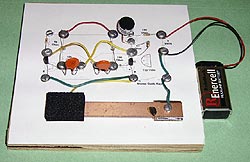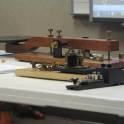CW - Morse Code - Brass pounding
We believe that although you don't have to KNOW CODE to pass a test, you may find great enjoyment in learning and using code.
Here are some "motivational" materials to consider. The materials include original articles and things we've pulled from friends on the web:
We don't recommend that you learn the code by looking at the dots and dashes on a piece of paper. You should try to learn it using sounds through one of the tools to follow. But if you want to peek at what radio morse code looks like, click here.
Here are some tools that can help you learn and use the MORSE code:
- K7QO CODE COURSE. Chuck has kindly offered his code course for us to use. We've included a few modules here on our site. You may get the entire course at Chuck's site but beware it's over 400 megs in size. Why so big? Well, it's done in MP3 format so you can load it on your iPOD/MP3 player and learn it while you're jogging or on your bicycle. Oh, by the way, Chuck copies over 100 Word Per Minute. In the "old" days, hams had to pass 5 WPM for Novice, 13 WPM for General, and 20 WPM for Extra class of license. So try some of the files clicking on them here: A-D A-H A-J A-N A-T A-Z Chuck has a whole lot more on this web site - www.k7qo.net
- LEARN MORSE CODE ONLINE - Go to www.lcwo.net and sign in to learn CW online. No program to download. SIGN UP for an “account” with your callsign. Then set character speed to 18 wpm and effective speed to 4 wpm. Check the letters in the word ESTONIA. If you do not know any letter, just check E and S to start, adding letters at the pace you wish. Also check the “VVV= / AR” button and SUBMIT the entries. On the main menu, click CODE GROUPS and in the Change Mode field, select Custom Characters. You are now ready to hit PLAY and copy code. The nice feature here is the place to actually type in the code as you copy it and have it graded! Good luck.
- JUST LEARN MORSE CODE - A great training program you download and put in the letters as we'll discuss later. Just go to the JLMC site and download the program. I prefer this to the G4FON program because I do not like the KOCH order of letters. G4FON also has a quirky space after the letter E! So use JLMC and set the speed on this one to 4 and 18 and enter a few of the letters in the word ESTONIA. Once you have these down, add some more until you know the word ESTONIA. For more on my preferred order go to w4qo.blogspot.com By the end of GROUP 2, you will know how to copy almost 24,000 words! Now, if you have a license - learn the remainder of your callsign - and GET ON THE AIR! Practice, practice, practice!
- CW-GET. Finally try this CW copy program. A trial version is available. To use it, just hook a simple audio cable between your earphone jack on your receiver and your sound card input on your computer. Try to copy by hand but have this running in the background as a cross check to fill in the missing letters. It's fun to use. Move the threshold line up and down for best copy. Thanks to UA9OV.
- CW FUN. If you'd like to hear how Morse Code sounds, try typing in a phrase and listening to it played back on your computer, click here.
- MORSE CODE PRACTICE SET. There are literally dozens of websites that show Morse Code practice sets and how to make them. However this one can be done without a soldering iron.
 A piece of wood, some brass screws and washers, some tin from a tin can, and some other stuff you can scrounge up, and you'll be able to make this one- click here. This site is from our national ham radio organization - the ARRL.
A piece of wood, some brass screws and washers, some tin from a tin can, and some other stuff you can scrounge up, and you'll be able to make this one- click here. This site is from our national ham radio organization - the ARRL.
If you want to buy a kit that is all inclusive (well, except for a 9v battery), then check out this site - click here.
- ASSESSING YOUR SKILL. Lastly, should you think copying code is just too difficult, check out this site where teenagers actually compete in copying code. The speeds are amazing: http://www.rufzxp.net/ They have a program called Tancredi where you can assess your skill level. Give it a try.
For a way to use Tancredi with USA or North American callsigns, click here.


 A piece of wood, some brass screws and washers, some tin from a tin can, and some other stuff you can scrounge up, and you'll be able to make this one- click here. This site is from our national ham radio organization - the ARRL.
A piece of wood, some brass screws and washers, some tin from a tin can, and some other stuff you can scrounge up, and you'll be able to make this one- click here. This site is from our national ham radio organization - the ARRL.